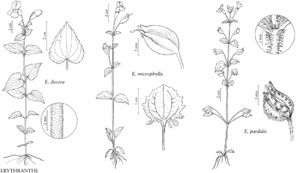Erythranthe microphylla
Phytoneuron 2012-39: 44. 2012.
Annuals, fibrous-rooted. Stems erect, simple, sometimes many-branched from basal cauline nodes, terete, sometimes distinctly 4-angled, (3–) 5–30 (–45) cm, glabrous below inflorescence, sometimes distals hirtellous, hairs commonly deflexed, or mixed hirtellous and stipitate-glandular, sometimes only short villous-glandular, hairs gland-tipped. Leaves basal and cauline, basal sometimes absent at flowering; petiole: basal or proximals to medials 3–25 (–35) mm, distals 0 mm (then blade subclasping to narrowly perfoliate); blade often purplish, palmately 3–5-veined, ovate or ovatelanceolate to elliptic-ovate, suborbicular, or depressed-ovate, (3–) 10–35 × 3–25 mm, base rounded to truncate or subcordate, margins shallowly crenate to sharply crenate-serrate, teeth 5–10 per side, basal and proximal often irregularly incised near petiole and sublyrate, apex acute to obtuse-rounded, surfaces glabrous or sparsely to moderately hirtellous, eglandular. Flowers herkogamous, 1–8 (–14), usually from distal nodes, chasmogamous. Fruiting pedicels 8–30 (–50) mm, distals hirtellous, hairs commonly deflexed, or mixed hirtellous and stipitate-glandular, sometimes only short villous-glandular, hairs gland-tipped. Fruiting calyces nodding 30–90º, sometimes red-tinged or dotted, ovoid-campanulate to broadly cylindric-campanulate, inflated, sagittally compressed, (7–) 9–16 (–20) mm, minutely hirtellous, hairs sometimes reduced to basal-cells, or glabrous, throat strongly to weakly closing. Corollas yellow to golden yellow or orangish yellow, usually red-spotted, abaxial limb sometimes with a large red splotch, bilaterally symmetric, bilabiate; tube-throat broadly funnelform, (6–) 8–16 (–20) mm, exserted (1–) 2–6 (–8) mm beyond calyx margin; limb expanded 8–25 mm, palate villous. Styles sparsely hirtellous. Anthers included, glabrous. Capsules included, 6–9 (–11) mm. 2n = 28, 56.
Phenology: Flowering Mar–Jul.
Habitat: Rock depressions, rocky ridges, cliff faces, roadcuts, wet meadows, seeps, stream banks, drying ponds, ephemeral stream channels, vernal springs over serpentine, roadsides and roadside ditches, dry banks, lava soils, loam, clay, gravel, yellow pine, oak-pine, mixed oak woodlands, oak-chaparral.
Elevation: 20–1700(–2600) m.
Distribution
B.C., Calif., Idaho, Nev., Oreg., Wash.
Discussion
Erythranthe microphylla is characterized by its annual duration (fibrous-rooted), usually simple stems, relatively widely spaced leaves, glabrous or hirtellous vestiture, open corollas, and calyces closing at the throat. Even in the smallest corollas, the stigma is positioned above the adaxial anther pair, indicating that all are primarily allogamous. Some plants have basal and proximal cauline leaves with exaggeratedly and irregularly toothed-incised margins (especially in Lake and Napa counties, California, as in the types of Mimulus glareosus and M. guttatus var. insignis, respectively), but a similar tendency can be seen over most of the geographic range. Plants of E. microphylla vary greatly in height, leaf size, and flower size (the larger flowers approaching the size of those in E. grandis and E. decora), yet all seem to be within the expression of a single species.
An inversion sequence of chromosome 8 (the DIV1 region) is perfectly correlated with the life history features of at least four species of sect. Simiolus (D. B. Lowry and J. H. Willis 2010). One sequence occurs in Erythranthe guttata and E. grandis, which are perennial and rhizomatous, occur in habitats with year-round moisture, and flower relatively late in the season, while the opposite sequence occurs in E. nasuta and E. microphylla, which are annual and slender-taprooted or fibrous-rooted, occur in quickly drying habitats, and flower in early season. The inversion, with its tightly linked, locally adaptive alleles, contributes to isolating mechanisms between species with contrasting sequences and preserves the constellation of features that makes each a recognizable entity.
Hybridization and apparent introgression occur among Erythranthe guttata, E. microphylla, and E. nasuta, yet each remains distinct in duration, perennating morphology, and habit. Erythranthe arvensis (annual) also is a member of this gene-sharing group. A whole-genome analysis by A. D. Twyford and J. Friedman (2015) showed that populations of E. guttata and E. microphylla cluster together within each of several geographically delimited regions; they interpreted their trees as showing phylogenetic relationships and concluded that E. guttata and E. microphylla are conspecific. Other evidence (G. L. Nesom 2014c, 2014d), particularly the DIV1 inversion sequence, indicates that E. guttata and E. grandis are most closely related to each other and were derived from an ancestor of annual duration. Thus, E. microphylla and E. nasuta are morphologically and phylogenetically distinct from E. guttata, despite extensive gene flow where they are sympatric with it.
Selected References
None.
